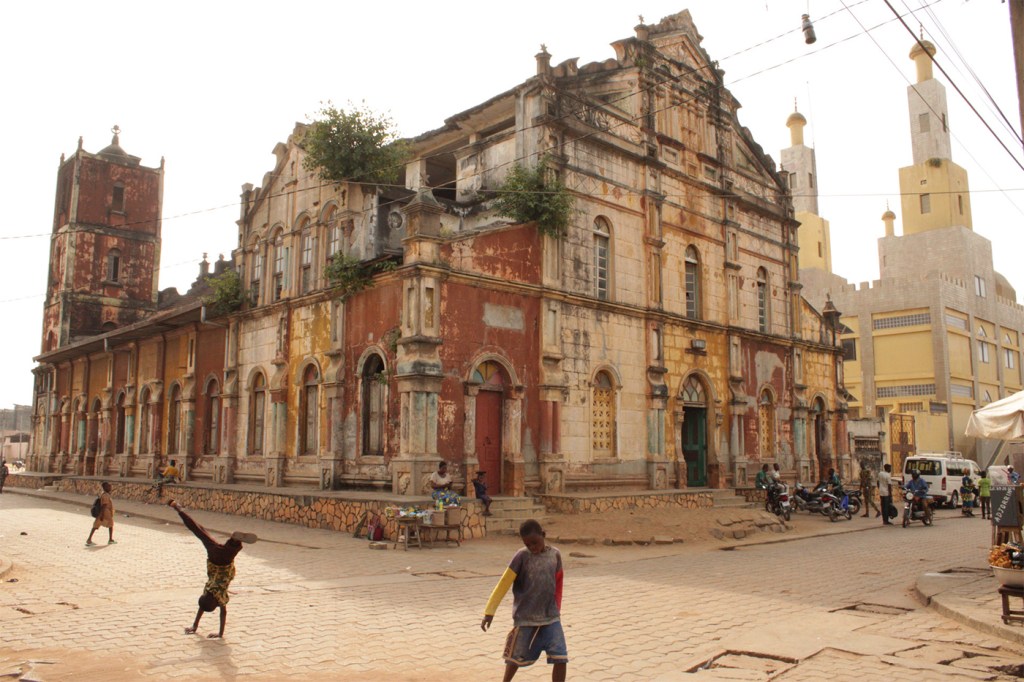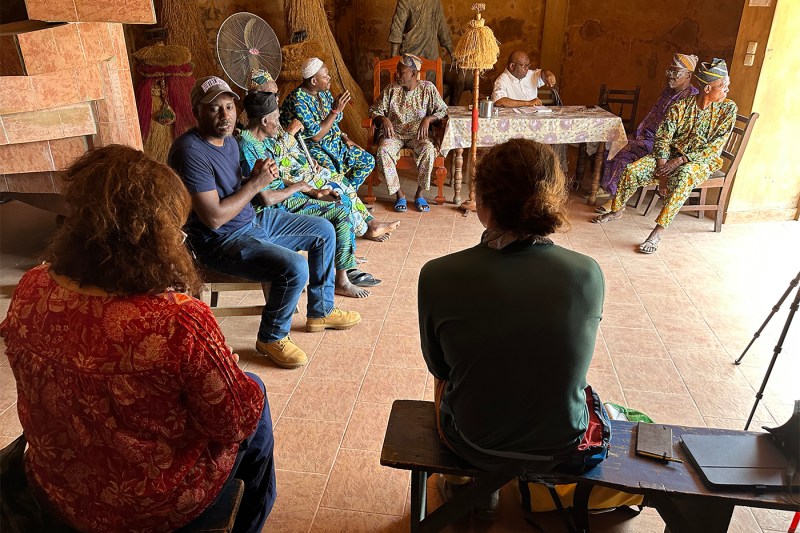Researchers use drones and VR to preserve at-risk African architecture
Combining traditional preservation methods with new technology, Northeastern’s African Building Heritage Project is a digital, interactive archive of Benin’s architecture that aims to grow into much more.

The Great Mosque of Porto-Novo stands in Benin’s capital city –– but just barely.
The once grand example of Benin’s unique Afro-Brazilian architecture, traced back to the Aguda community, has struggled to withstand the test of time. A large chunk of its vaulted ceiling has collapsed, the minarets are crumbling and invasive trees are growing through the walls.
Porto-Novo community leaders want to see the mosque preserved and converted into a museum documenting the Aguda community and Islam in the West African country, but the precarious condition of the building makes that future questionable.
However, a group of researchers at Northeastern University are working to make sure the mosque lives on through the African Building Heritage Project, an innovative preservation project done in collaboration with people in Benin.


Helmed by an interdisciplinary team of architects, historians and tech experts, the African Building Heritage Project is a digital, interactive archive of at-risk buildings, and the stories behind them, in Benin’s capital. Using a combination of traditional photography and oral interviews with drone-mounted geospatial scanning and virtual reality, the team at Northeastern aims to create a technological foundation that can then be adapted in countries across West Africa where preservation efforts are less robust.
“Building heritage to me is part of an identity,” says Killion Mokwete, an assistant professor of architecture at Northeastern and lead on the project. “We talk about cultural resiliency. You can’t remove buildings and culture and heritage from that conversation.”
“We’re not just preserving these buildings –– we’re preserving the stories that go with these buildings,” adds Jessica Parr, a professor of the practice in history and director of public history at Northeastern. “The buildings themselves are, in many respects, historical documents. They’re ways to teach and preserve the past and think about what stories get privileged, what stories get told, what stories get passed down beyond the oral histories.”
Editor’s Picks
In Benin, and Porto-Novo specifically, some buildings have been destroyed or damaged by war, others by environmental issues exacerbated by climate change. In some cases, the bureaucratic systems or financial resources needed to preserve older buildings don’t exist. More broadly, training in heritage preservation has historically emphasized Western architecture, Parr says, while deprioritizing African buildings.
The team interviewed people in Benin to learn more about the histories of the eight buildings they focused on for the first part of the project. The broader aim is to contextualize that history within the stories of the people and communities that use those buildings.
The interviews are part of the archive but also a tool that the team’s local partners, Ecole du Patrimoine Africain, the School of African Heritage, can use to make the case for grant funding and registering these buildings with agencies like UNESCO.
But the goal of the project from the outset was always to make that history more accessible and interactive than a traditional archive, Mokwete says.
With the help of Bahare Movahed-Sanaie, a geospatial specialist at Northeastern’s library, Mokwete and the team used tripod and drone-mounted LiDAR scanners to map the interiors and exteriors of at-risk buildings. The data collected from LiDAR scans can then be used to develop architectural blueprints, 3D models or even 3D tours.
Mark Sivak, an art and design teaching professor at Northeastern who specializes in virtual reality, also converts those scans into immersive VR experiences.
Patricia Davis, an associate professor of communication studies, says the project’s focus on immersing people in architecture can help remedy some of the global narratives that have historically dismissed or ignored African history.
“When you look at this huge, ornate mosque, even if you’re just looking at a skeleton of it, … you can imagine a different conceptualization of the society that produced such a structure back during the time, and it subverts these narratives that suggest that Africans have no history,” Davis says.
The project is leaving its pilot phase, which involved constructing a digital archive of eight buildings that represent that breadth of Benin’s architectural styles. There are palaces and temples from Benin’s pre-colonial past, cathedrals and institutional buildings from the country’s colonial period and, most importantly for the team, Aguda buildings like the Great Mosque.
Despite the prominent place the Aguda community held in Benin’s society, its history has “been pushed into the cultural outskirts and there hasn’t been a lot of attention paid to trying to document and record and share their history,” Parr says.
The Aguda community, or Afro-Brazilian community, was formed from intermingling groups of slave catchers, who were of European descent, and formerly enslaved people and their descendants who returned to Benin from Brazil post-emancipation.
Formerly enslaved people faced even more discrimination upon returning to Benin, Mokwete says, and architecture became a way to reclaim some kind of power.
“People who returned were really determined to create a new identity for themselves and to not be seen as a sub-people,” Mokwete says. “It really drove them to build buildings that were of high status, of elevated status.”
Eventually, the Aguda community grew to become a powerful part of the urban core in Porto-Novo and throughout Nigeria and Togo too. Their buildings, which evoke Brazilian and Portuguese architecture, remain a testament to the community’s once prominent place in the fabric of Benin.
Starting on Nov. 8, the team’s work will be on display in an exhibit that will last through November. It will include photos, 3D models and interactive versions of the buildings that people can “walk through” in VR, Mokwete says. Mokwete will then bring the exhibit to Benin in December as part of a community engagement effort.
The end goal is to expand the project to other West African countries, training local partners in the technology and archival work so they can take a more active role in preserving their buildings and creating a broad digital mosaic of African architecture.
“We are helping with the infrastructure, we’re helping with the training, we’re doing at least some of the initial technical heavy lifting, but we’re very much partners with our colleagues in Benin,” Parr says. “The data, the artifacts, that’s their stuff; that’s not ours.”











